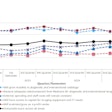DENVER - Some longtime radiologists would say that studying for the boards in the 1970s was a lot more straightforward than it is today. The primary imaging modalities were simple: plain film x-rays, angiograms, and barium studies.
But things started getting a lot more complex in the late '70s through the late '80s, with the introduction of CT, ultrasound, and MRI. And with the giant advances these technologies have made in the past 15 years, the practice of radiology has gotten even more complex, according to Dr. Frank Seidelmann, a clinical professor at Ohio University in Athens, OH, and chair of the teleradiology company Franklin & Seidelmann Subspecialty Radiology in Beachwood, OH.
"Now we can see into the human body on a molecular level," Seidelmann said. "There have been tremendous advances in imaging -- the knowledge base is exploding with modalities such as functional MRI, breast MRI, PET, and CT/PET fusion."
With this complexity comes an impetus toward specialization. At the 2008 American Healthcare Radiology Administrators (AHRA) meeting, Seidelmann argued that subspecialization has moved from the margins of radiology practice to front and center.
A perfect storm
What has contributed to the move toward subspecialization? Several factors, according to Seidelmann, including a radiologist shortage, technology advances, radiology error rates, and economics and competition.
Radiologist shortage?
In the 1990s, the demand for diagnostic radiology outstripped the supply of radiologists due to natural attrition: as the U.S. government started cutting reimbursement to manage utilization, fewer and fewer medical students chose to pursue radiology. With the fact that total training to become a radiologist can take as long as 13 years (with subspecialty experience consisting of about two years of that total), it's difficult to get trained radiologists into the workforce quickly.
"The word was out that radiology was a bad field," Seidelmann said. "Medical students weren't going in, and the pipeline dried up."
There's talk that the shortage has abated, but that perception is more due to the fact that radiologist productivity has increased with PACS, voice recognition technology, and teleradiology. With that increased productivity comes longer working hours and a natural progression toward subspecialization in an attempt to become more efficient.
Technology advances
Technology advances have played a huge part in the trend toward subspecialization, Seidelmann said. In the mid-1980s, personal computers emerged in the mainstream; with the advent of DICOM and remote viewer technology, radiologists can now interpret exams via sophisticated computer connections anywhere in the world.
"The technology means that there has been a decoupling of who has to be onsite and how images are read," Seidelmann said.
Error rates
Error rates have been high in radiology, with some estimates as high as 30%, according to Seidelmann, who attributed this to the sheer mass of data that radiologists have to deal with on a daily basis.
"In the '70s, you could do it all," he said. "But all these modalities caught us off guard. No one radiologist can do all of it."
To remain competitive -- by providing the best possible patient care -- it's crucial that radiologists reduce error rates, at least to the single digits. Subspecialization is one way to work toward this, Seidelmann believes.
Economics ... and competition
It's common knowledge that imaging, particularly MRI and CT, has had some of the highest growth in healthcare spending over the past five years. The American College of Radiology (ACR) estimated in 2004 that 470 million procedures were performed in 2001, and that amount was expected to grow 4% to 6% over the next decade. The ACR also estimated that the U.S. imaging services market was $100 billion in 2000.
As the government passes legislation to curb medical imaging spending and as reimbursement declines, independent diagnostic testing facilities (IDTFs) and hospitals will try to increase referrals by using quality interpretations as a way to differentiate themselves from the competition, Seidelmann believes -- another reason subspecialization looks not only attractive, but essential.
A new radiology staffing model
Since the 1990s, the staffing model in radiology groups consisted of general, onsite radiologists, on-call home teleradiology for preliminary reports only, and centralized reading of musculoskeletal or neuroradiology exams. In 2000, the model adjusted to include centralized readings and final interpretations with subspecialists, so-called nighthawk radiology, and locum tenens staff.
So what is the future staffing model? An integrated hybrid of onsite and remote radiologists working with professional radiology provider support services, according to Seidelmann. The remote radiologists will interpret multispecialty and night exams, and onsite radiologists will interpret general exams and women's imaging cases and provide department or group leadership. The professional radiology provider organization will support workflow, system, and report integration; billing and licensing; operations management; and marketing and communications for the enterprise.
Seidelmann quoted an article by Dr. Scott Atlas, published in the November 2007 Journal of the American College of Radiology (Vol. 4:11, pp. 752-753), in which Atlas wrote that "there is no field in clinical medicine with a greater need for change than the practice of radiology," and "the vulnerability of the practice of radiology lies in the failure of clinical radiology practices to fully implement subspecialty practice."
As the U.S. population ages, the need for imaging services is not going to decrease, Seidelmann said, and as new applications emerge and the technology again increases in complexity, so will the demand for clinically specific diagnostic interpreters.
"We're moving from being body specialists to being information specialists," he said. "We need to provide clinically useful information that can go to whatever person in the organization makes the specific care decision [for the patient]."
By Kate Madden Yee
AuntMinnie.com staff writer
August 1, 2008
Related Reading
Large radiology practices show growth, June 27, 2008
Doing due diligence: What to consider in mergers with nonradiology groups, June 12, 2008
The best way to run your practice? Look to corporate America, April 3, 2008
Want to survive in a post-DRA world? Start talking, March 4, 2008
Multiple industry trends increase demand for subspecialty radiology, October 5, 2006
Copyright © 2008 AuntMinnie.com




















